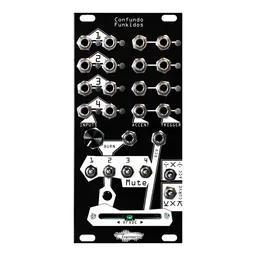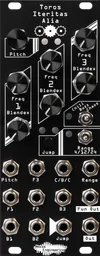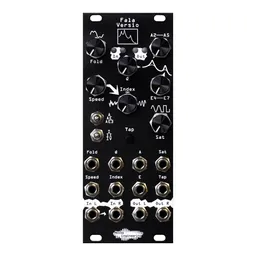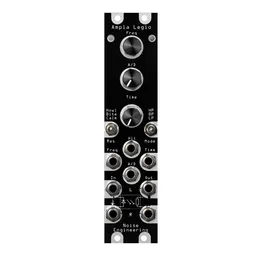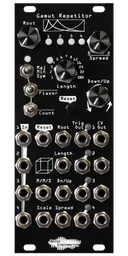Randomness is a wonderful thing. Here at Noise Engineering, we’re longtime fans of randomized sequencing and voltage generation, and we’re excited to introduce another generative utility for all your sequencing needs. Meet Gamut Repetitor: a four-channel random looping quantized voltage and trigger generator!

The Backstory
If you attended the Buchla and Friends event back in January, you may have seen us show off a module called Pax Digitalis, the working name for Gamut Repetitor. A couple of weeks ago, we showed off the final version of Gamut Repetitor at the Los Angeles Synth & Pedal Expo. At both shows it received glowing praise, and we’re thrilled to finally release it into the wild.
We’ve long been inspired by things like the Source of Uncertainty that give you some amount of control over random quantized voltages. A couple of years back we decided we wanted to design some sort of controlled random sequencer, and drew some concepts and designs.
A few things became clear quickly: we wanted a way to make randomized sequences repeat, we wanted some sort of scale and key controls, and we wanted it to be easy to control the types of generated voltages. Eventually we settled on the control layout that you see in the final module, and dove into firmware development.
A few challenges arose in the firmware process. Deciding on the range and behavior of the Root, Spread, and Direction controls was relatively straightforward – we just had to make sure that it was broad enough to be versatile but still usable. Length was more tricky; first, we had to decide how many loop lengths we could comfortably fit on the knob. Once we had a selection we were happy about, we had to figure out how to communicate the selected length to the user. Panel labeling along with LED changes to show length changes ended up being quite effective, and at that point we were happy with the overall experience of manipulating all aspects of sequence generation.
That just left scale selection, which turned out to be a near Sisyphean task. As you can imagine, there are a lot of useful scales and selections of intervals, and finding the ones we wanted to include and organizing them in a useful way was… a challenge. Starting out, we knew that we wanted a few obvious options (major scale and triad, a few flavors of minor scales and triads), as well as chromatic and octave-only selections, reminiscent of random generators past. Shawn and Stephen spent a huge amount of time chatting about interesting scales and patterns, pulling from their own compositional experiences and taking inspiration from books like A Geometry of Music and Thesaurus of Scales and Melodic Patterns. Once a final set of scales had been selected, they spent some more time organizing them to be as musical as possible as the switches were manipulated, and then Markus had the task of making sure all scales had been implemented correctly. The work paid off, though: it’s quick and easy to dial in a scale by ear, and if you want to pick a specific set of notes, there’s a handy scale chart in the user manual.
Near the end of development, trigger pattern generation was added to round out the featureset of the module – it was an easy add that opened up a lot of new patch possibilities – and the module was finished.
In use
Gamut Repetitor is simple to use and can rule an entire patch, or play a more subtle part in a bigger generative system. At the Synth and Pedal Expo, GR was running from a single clock most of the weekend, sequencing a few voices and creating a whole bunch of beautiful melodies as attendees played around with its different controls.
Each channel of Gamut Repetitor can also be clocked individually, for total control of random advancement. The Root parameter will change the key of your pattern, with the three scale switches selecting the notes used. Spread will change the range of notes from zero semitones to two octaves from the Root, and Down/Up changes how far above and/or below the Root note the pattern goes. Length sets the loop length: all the way up is infinite, and steps below that repeat a certain number of steps, with settings for 1 through 8, then 12, 16, 24, and 32 steps.
We’ve done an extensive amount of patching with it in our own systems (once you patch it up, it’s hard to put it down), oftentimes using CV to further manipulate its generated sequences. One of my personal favorite techniques is using another CV sequencer like Mimetic Digitalis to change keys by modulating the Root parameter, or create variations by occasionally changing the setting of the Spread parameter. With so many CV outputs, it can sequence multiple voices, generate CV for modulation, or both – the possibilities never end!
To get an idea of some of the things it can do, check out the official manual video:
You can learn more about Gamut Repetitor at the product page. It’s shipping now and available in black and silver, so you can pick one up from your favorite retailer or our webshop now, too!
